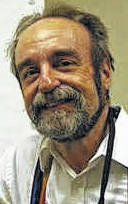
By Tom Burns
Stargazing
The next few days offer an excellent opportunity to find and observe the planet Uranus. Wait until darkness falls at about 8 p.m. Then, look for the brilliant planet Venus low in the western sky. Tonight (March 29), Uranus is just to the left and slightly above Venus.
By March 30, Venus has moved slightly above Uranus. Venus will continue to move until it is directly above Uranus by April 2.
Technically, Uranus is just above naked-eye visibility. However, fading twilight and city light pollution make Uranus a difficult object to see with just your eyes alone. Your trusty binoculars increase your chance of viewing it. Look for a pale, blue-green “star.”
The “star” will expand into a tiny dot in a telescope of any size at medium magnification. Sorry, that’s all you get.
In 1781, humans knew about five planets (excluding Earth), the same number known since humanity’s dim beginnings.
In the early 1600s, the astronomical telescope appeared, fundamentally changing our view of the cosmos.
Unfortunately, a decent telescope cost a king’s ransom to build. You were out of luck unless you were a professional astronomer supported by a wealthy private patron.
William Herschel was an amateur astronomer who decided to make a telescope himself. His life epitomizes a critical moment when a single human being, who also happened to be an immigrant, could change our view of the cosmos if that person were gifted and dedicated enough to do so.
Herschel had emigrated from Germany to England to escape the ravages of war. An accomplished musician, he made a good living traveling from one musical job to another across England, performing concerts on the oboe, harpsichord, violin, and church organ.
His musical talent and natural intellectual curiosity led him to want to experience the harmonies of the universe for himself.
In those days, astronomy enthusiasts used lens-based refractors to study the sky. However, refractors were expensive and difficult to make. They also produced objectionable color fringes that we call chromatic aberration today.
The reflecting telescope, invented in 1668 by Isaac Newton, was slowly coming into fashion. Herschel decided to build one himself.
Mirrors were painfully cast and polished from disks of speculum metal, a mixture of copper and tin. A telescope maker had to slowly and painstakingly grind and polish the mirror to an exact, concave surface. Because the metal tarnished quickly, the mirror had to be repolished every few months.
Herschel took a course in mirror fabrication from a local optician. With the help of family members, he cast the discs, ground them, and polished them for up to 16 hours a day, mixing his telescope obsession with his other duties as organist and composer.
He produced an instrument with a six-inch-diameter mirror as his second telescope, a beginner’s ‘scope by today’s standards.
With it, he systematically scanned the entire English sky and recorded everything he saw.
On March 13, 1781, just after 10 p.m., Herschel pointed his small telescope toward the constellation Taurus and saw a bluish dot.
At first, he concluded that the mysterious blue dot must be a comet or a star resolved into a tiny disc.
Four nights after his discovery, Herschel observed the strange object again. Now he was sure it was a comet because it had moved slightly against the fixed background of stars.
Herschel had made the most significant discovery in astronomical history but didn’t know it.
He observed the object over several months, carefully recording its changing position. His detailed positional data allowed Swedish mathematician Anders Lexell to compute the object’s nearly circular orbit around the sun.
The object was 19 times farther from the sun than Earth and with a startling orbital period of 82 years. At that distance, it must be 35,000 miles wide, over four times the diameter of our planet.
Herschel had not spotted a mere comet. He had become the first person since the dawn of human history to discover a new planet.
Fame and governmental patronage soon followed. Today, we remember him as the discoverer of Uranus. Amateur astronomers like me think of him as one of their own, a hobbyist who rose to professional greatness by patient exercise of his extraordinary talents.
Tom Burns is the former director of the Perkins Observatory in Delaware.

